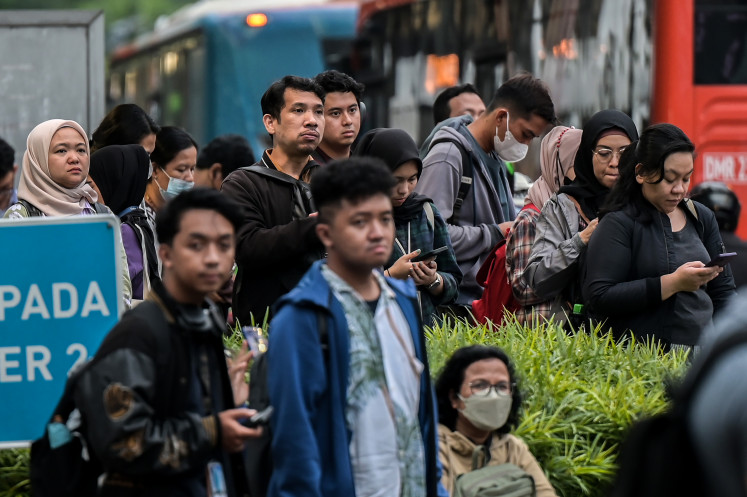Popular Reads
Top Results
Can't find what you're looking for?
View all search resultsPopular Reads
Top Results
Can't find what you're looking for?
View all search resultsYear ender: Big-budget local films buck lackluster box office
People in the local film industry still talk about the years between 2007 and 2010, when 15 local films dominated the box office, each attracting more than 1 million viewers
Change text size
Gift Premium Articles
to Anyone
People in the local film industry still talk about the years between 2007 and 2010, when 15 local films dominated the box office, each attracting more than 1 million viewers.
The movies included Riri Riza'a immensely popular and critically acclaimed big-screen adaptation of Andrea Hirata's novel Laskar Pelangi (Rainbow Warriors), Hanung Bramyanto's religious melodrama Ayat-ayat Cinta (Versus of Love) and comedy Get Married, and Ifa Isfansyah's kids' soccer film Garuda di Dadaku.
However, in the last four years, only seven films have broken the 1 million mark. Overall, audience numbers have declined from 30 million in 2010 to less than 15 million a year.
While fewer tickets sold might have led to artistic conservatism, local filmmakers and producers have made 2014 a year of diversity rather than austerity for Indonesian cinema, releasing many high-budget and high-concept films.
Director Ifa Isfansyah, whose martial arts actioner Pendekar Tongkat Emas (The Golden Cane Warrior) is now screening, summed it up the best: 'If you want to really attract the attention of the movie-going public in Indonesia, you have to present something convincing, something 'wow'.'
Ifa's The Golden Cane Warrior is an artistic gem and a lavish tribute to classic kung-fu flicks. The film's budget of around Rp 25 billion transformed Sumba, East Nusa Tenggara, with villages, fighting arenas, and martial arts dojos built from the scratch.
In a first for local film, a world-renowned martial arts artist and fighting choreographer ' Xiong Xin Xin ' was recruited to take care of action scenes.
Another film making headlines is Supernova: Ksatria, Putri, dan Bintang Jatuh (Supernova: The Knight, the Princess, and the Falling Star), directed by Rizal Mantovani.
Supernova follows production company's Soraya Intercine's strategy of releasing high-profile literary adaptations for the December holiday period, which it also did in 2013, with Tenggelamnya Kapal van der Wijck (Sinking of the van der Wijck) and in 2012, with 5 CM.
Rizal's Supernova, adapted from author Dewi Lestari's so-called unfilmable novel on a budget of around Rp 20 billion, boasts spectacular CGI effects, from pigeons coming out of pillows to vistas of galaxies far far away, to visualize the subjective perspectives that makes up the film's love story.
However, the No. 1 box-office hit for 2014 is likely to be February's Comic 8, with 1.6 million paid admissions.
The film ' a bank-heist-gone-wrong story headlined by an ensemble of local comedians ' is an admirable (and amusing) rehash of many Guy Ritchie or Quentin Tarantino films, featuring intertwined criminal plots, hyper-stylized cinematography, uber-cool violence and an abundance of Mexican standoffs.
Coming in at No.2 with 1.3 admissions was The Raid 2, a follow-up to the massively successful martial-arts film The Raid. This time, director Gareth Evans took on a bigger playground for his fights: Jakarta itself.
However ' just as in Supernova ' the Jakarta featured in The Raid 2 is a pseudo-Jakarta. In Evans' film, the capital is split by Japanese yakuza mobsters and local preman (thugs). It even somehow snows during some dramatic battles.
However, the artisitic health of local cinema lies in the quality of its independent or arthouse films and not in box-office numbers.

Running on fewer screens and microscopic promotion budgets, arthouse films whither on the vine, never penetrating local consciousness. It's a shame, really, because many of the films are interesting works waiting to be discovered.
On the independent front, this year, we had Cahaya dari Timur: Beta Maluku (We are Molluccans), Angga Dwi Sasongko's latest feature, featuring a Citra-winning turn by Chicco Jerrikho as a part-time soccer coach for Muslim and Christian kids against a backdrop of relgious and ethnic violence in Maluku.
There was also Tabula Rasa, the debut feature of Adriyanto Dewo, also touches on diversity, using cuisine (in this case Padang food) to bring together a former football player from Papua and a family of refugees.
Also worth mentioning are Selamat Pagi Malam (English title: In the Absence of the Sun) by Lucky Kuswandi and Sebelum Pagi Terulang Kembali (Before the Morning After) by Lasja Susatyo.
Lucky's film, chosen as the closing night film of the Singapore International Film Festival, was a character study of Jakarta, focusing on the existential yearnings of the bourgeois to the heady adventures of the young workers.
Lasja's Sebelum Pagi, meanwhile, was a rumination on corruption in Indonesia through the perspective of a family of salarymen and entrepreneurs.
On the arthouse note, there were two notable films that booked mainstream releases in 2014: Toilet Blues by Dirmawan Hatta and Vakansi yang Janggal dan Penyakit Lainnya (Peculiar Vacation and Other Ilnesses) by Yosep Anggi Noen.
Both films feature protagonists searching for meaning while taking road trips to nowhere. Both also made bows in many prestigious film festivals around the world; Busan and Rotterdam among them.
Two local filmmakers emerged as talents to watch after screenings at at major international film festivals: Sidi Saleh, a cinematographer for auteur director Edwin, who saw his short Maryam become the first Indonesian film ever to win at Venice; and Aditya Ahmad, a recent graduate from the Arts Institute of Makassar, who saw his Sepatu Baru (On Stopping the Rain), receive special mention at the Berlinale.
Indonesian cinema is never short on talent and ambition, and those are good things to have in such testing times. The box-office figures might have been declining, but the most important thing is to keep delivering the goods, to show the world that Indonesian cinema deserves a second chance from its own people.
One thing we could learn from this: it takes more than poor box-office earnings to stop Indonesian cinema. The future is bright.
_______________
The writer, a film critic, is co-founder of Cinema Poetica and a researcher for Film Indonesia.











